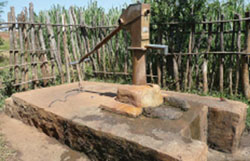15.3 Protection of wells
15.3.1 Types of well
There are several different ways of constructing a well in order to access groundwater sources. These include dug wells, bored wells (also known as boreholes), and driven and jetted wells.
Dug well
A dug well is usually excavated by hand, but may be dug by mechanical equipment. They are usually 90–180 cm in diameter and 4.5–10.5 m deep, depending on where the water-bearing layer or groundwater is encountered. Wider and deeper dug wells are less common. Dug wells have a relatively large diameter and therefore have large storage capacity, but the water level will be lower at times of drought and the well may go dry. On the other hand, during heavy rain, dug wells are susceptible to contamination by pathogens which may be deposited on the surface or naturally present in the soil and are washed in to the well, particularly if it is improperly constructed. Handpumps placed over the well need to be built so the surrounding ground is covered and protected (Figure 15.5). Any pipework associated with pumps that enters the well needs to have watertight connections so there can be no contamination from surrounding soil.

Bored well
Bored wells or boreholes are constructed with a hand- or machine-driven auger and tend to be used in relatively soft soils and rocks. An auger is a device with a rotating blade that is used to drill holes and draw out the loosened rock and soil. Bored wells vary in diameter from 5–75 cm and in depth from 7.5–18 m. A lining, known as a casing, of concrete, metal, or plastic pipe is necessary to line the hole and prevent the soil and rock from caving into the well. Bored wells have characteristics similar to dug wells in that they have small yields, may be easily polluted, and are affected by droughts.
Driven and jetted wells
These types of well consist of a metal pipe with a screen attached at the bottom end. A well screen is a device that allows water to pass in to the pipe but keeps out soil particles. The pipe is driven or jetted into a water-bearing rock layer found at a comparatively shallow depth. For a driven well, the end of the pipe is shaped into a point and it is hammered into the ground. The jetted well is constructed by directing a high velocity stream of water through the bottom of the pipe, thereby loosening and flushing out the soil which is forced back up to the surface as the pipe is lowered. Driven wells are commonly 2.5–5 cm in diameter and less than 15 m in depth. Jetted wells may be 5–30 cm in diameter and up to 30 m deep. Larger and deeper jetted wells can be constructed. Following development, the well should be tested to determine the dependable well yield (I.e. the volume of water reliably produced). The well is then disinfected and the project completed.
15.2.6 Water quality
